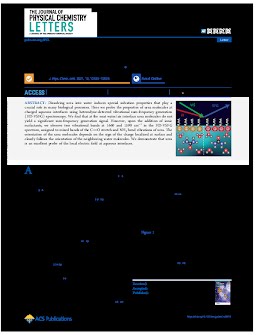2021-11-02
Direct Observation of the Orientation of Urea Molecules at Charged Interfaces
Publication
Publication
J. Phys. Chem. Lett. , Volume 12 - Issue 44 p. 10823- 10828
Dissolving urea into water induces special solvation properties that play a crucial role in many biological processes. Here we probe the properties of urea molecules at charged aqueous interfaces using heterodyne-detected vibrational sum-frequency generation (HD-VSFG) spectroscopy. We find that at the neat water/air interface urea molecules do not yield a significant sum-frequency generation signal. However, upon the addition of ionic surfactants, we observe two vibrational bands at 1660 and 1590 cm-1 in the HD-VSFG spectrum, assigned to mixed bands of the C O stretch and NH2 bend vibrations of urea. The orientation of the urea molecules depends on the sign of the charge localized at surface and closely follows the orientation of the neighboring water molecules. We demonstrate that urea is an excellent probe of the local electric field at aqueous interfaces.
| Additional Metadata | |
|---|---|
| ACS | |
| European Research Council (ERC) | |
| doi.org/10.1021/acs.jpclett.1c03012 | |
| J. Phys. Chem. Lett. | |
| Organisation | Ultrafast Spectroscopy |
|
Moll, C., Versluis, J., & Bakker, H. (2021). Direct Observation of the Orientation of Urea Molecules at Charged Interfaces. J. Phys. Chem. Lett., 12(44), 10823–10828. doi:10.1021/acs.jpclett.1c03012 |
|
